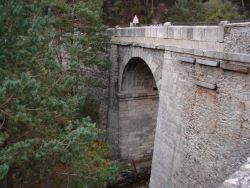
A few years ago, I had the pleasure of teaching a course on the Spanish Civil War in Literature and Film. We started with some nonfiction films produced both during the war (as propaganda) and many decades later as historical documentaries. The students later reported that those films enabled them to visualize the war in our literary texts. It helped those texts, and that history, come alive. I hadn’t anticipated that benefit but was delighted to hear about it.
Working on Reading Hemingway’s For Whom the Bell Tolls: Glossary and Commentary—the ninth and final volume in Kent State UP’s remarkable series—(missing, alas, In Our Time)—has been an absolute joy. Its line-by-line format removed the need to structure a book-length argument, leaving me with only the pleasure of the research. Of discovery. I like to imagine readers will share my moments of Wow! Who knew?!
Some significant discoveries were photographic and pictorial. Visual evidence, for example, helped me identify the kind of tank that fired the round that brought about Robert Jordan’s death, significantly a captured Republican tank. An illustration from a February 1937 Republican Ministry of Propaganda publication may have contributed to Hemingway’s description of the violent head-shaving of Maria.
Reading Hemingway’s For Whom the Bell Tolls could incorporate only so many images, and it occurred to me that the novel’s readers might, like my students in that course, appreciate some assistance with seeing the story. Robert Jordan receives his mission from General Golz a stone’s throw from El Escorial, a detail that hardly registered the first dozen or so times I read the novel until I bothered to find images of this humongous edifice that in its day boasted being the largest building in the world and one of the manmade wonders of the world. The “tank” that Jordan commandeered at Carabanchel he also calls an “armored car,” the accurate term, and seeing a photo of one allows us to picture that scene.
Other images, if not directly about the novel, nevertheless illuminate the context and, frankly, thrilled me to find. As soon as I saw Modesto Ciruelos’s 1936 painting Descubierta, I envisioned the book’s cover—and, for the first time, felt the book coming into being. The painting depicts fighting in the Sierra de Guadarrama early in the war—not only the mountains of the novel’s timeframe, but combat that Jordan participated in, alongside if not a member of the communist-led Fifth Regiment. The painting’s title, Discovered, speaks to the novel’s almost-title, “The Undiscovered Country,” while expressing my book’s research hopes.
Carl Eby’s excellent digital resource “Seeing Hemingway’s The Garden of Eden,” which curates 150 visual artifacts he couldn’t publish in Reading Hemingway’s The Garden of Eden (only a portion of his related collection), inspired me to assemble a far more modest such companion to Reading Hemingway’s For Whom the Bell Tolls, offering images not included in that book. I hope the “Picturing For Whom the Bell Tolls” webpage helps recreate for readers the world of Hemingway’s 1940 revolutionary romance. And I hope readers and viewers will join the cause by suggesting additional images for future updates.
Alex Vernon is the M.E. and Ima Graves Peace Distinguished Professor of English at Hendrix College in Conway, Arkansas. His work on Hemingway includes Soldiers Once and Still: Ernest Hemingway, James Salter, and Tim O'Brien (2004); Hemingway's Second War: Bearing Witness to the Spanish Civil War (2011); the edited collection Teaching Hemingway and War (2016); and the newly published Reading Hemingway's For Whom the Bell Tolls: Glossary and Commentary (2024).